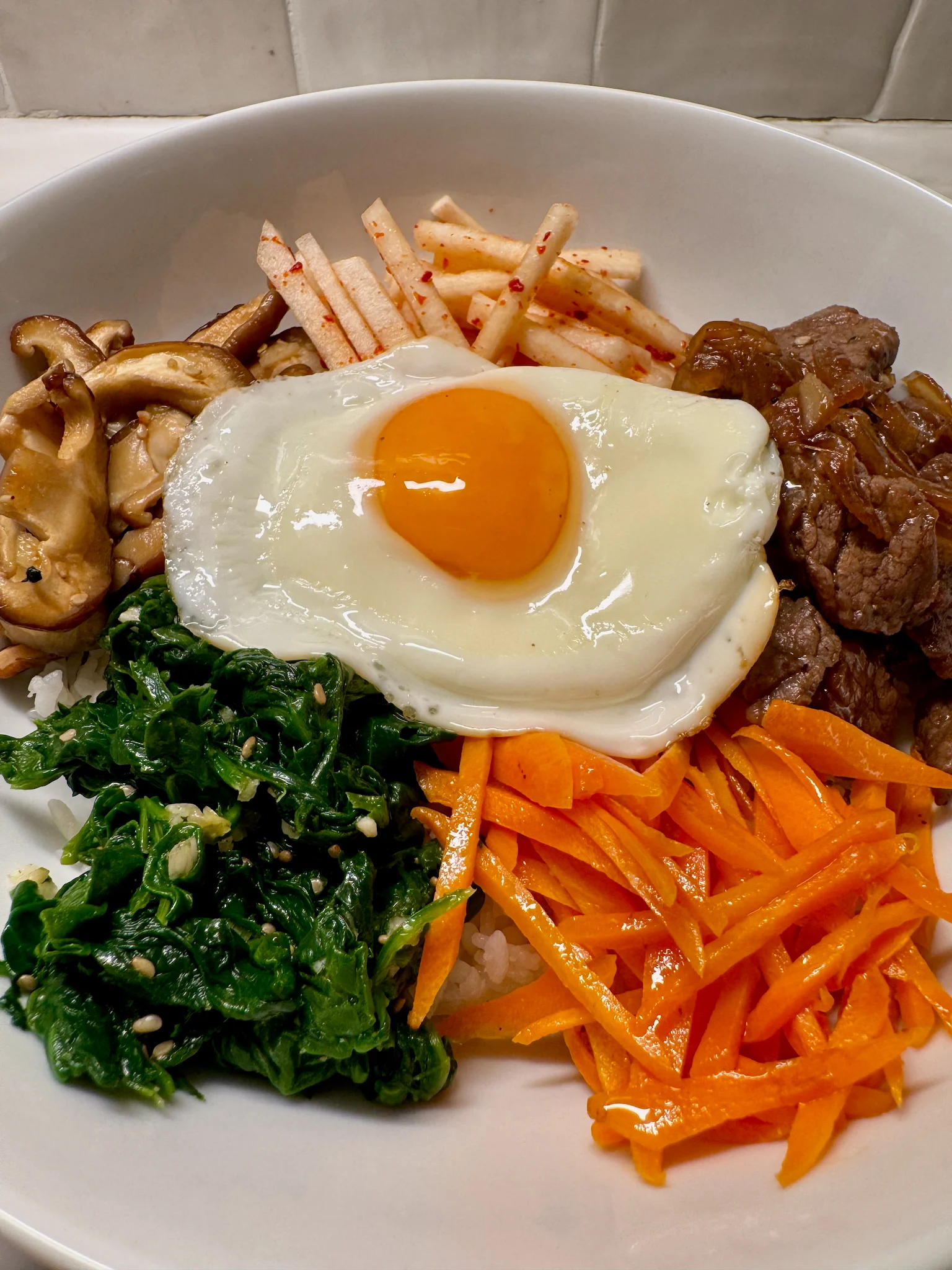Korean Bibimbap represents the artistic beauty of Korean cuisine, where individually prepared ingredients come together in a stunning arrangement before being mixed into a harmonious whole. This dish, whose name literally means “mixed rice,” originated during the Joseon Dynasty but has evolved to become one of Korea’s most internationally recognized dishes. The careful arrangement of colorful vegetables around a mound of rice creates an edible canvas that exemplifies the Korean principle of eating with your eyes first.
What makes bibimbap particularly special is its versatility and visual impact. Each component is seasoned and cooked separately to maintain its distinct flavor and texture, while the final mixing creates a perfect balance in every bite. The dish showcases the Korean approach to balanced eating, incorporating a variety of vegetables, protein, and grains in a single bowl.
In modern Korean dining, bibimbap has adapted to contemporary tastes while maintaining its essential character. Whether served in a sizzling stone bowl (dolsot bibimbap), prepared as a vegetarian option, or customized with various proteins, bibimbap continues to captivate diners worldwide with its perfect combination of flavors, textures, and visual appeal.
Why You’ll Love This Recipe
- Customizable ingredients
- Beautiful presentation
- Healthy and balanced
- Perfect meal prep
- Rich in vegetables
- Great for using leftovers for a quick 30min meal!
What is Bibimbap?
Bibimbap (비빔밥) is a Korean rice bowl topped with individually seasoned vegetables, protein, a fried egg, and gochujang sauce. The components are artfully arranged over rice before being mixed together just before eating, creating a harmonious blend of flavors and textures.

Korean Mixed Rice Bowl
Ingredients
For the Base:
- 4 cups cooked rice
- 4 eggs
- 8 oz ground beef or thinly sliced beef
For the Vegetables:
- 2 cups spinach blanched
- 1 cup bean sprouts blanched
- 1 carrot julienned
- 1 zucchini julienned
- 8 oz mushrooms sliced
- 1 cup gosari (fernbrake) gosari, optional
- 4 sheets kim seaweed, cut into strips
For the Meat Seasoning:
- 2 tbsp soy sauce
- 1 tbsp sesame oil
- 2 cloves garlic minced
- 1 tsp sugar
- Black pepper
For the Bibimbap Sauce:
- 4 tbsp korean red pepper paste (gochujang)
- 2 tbsp sesame oil
- 2 tbsp sugar
- 2 tbsp water
- 1 tbsp vinegar
- 1 tbsp sesame seeds
Instructions
Rice Base:
- Rinse short-grain rice until water runs clear
- Cook 2 cups rice in rice cooker or pot
- Let rest 10 minutes after cooking
- Fluff with rice paddle
- Keep warm until serving
Prepare Vegetables:
- Spinach: blanch, squeeze dry, season with sesame oil and salt
- Bean sprouts: blanch, season with sesame oil and salt
- Carrots: julienne, sauté until crisp-tender
- Mushrooms: slice, sauté until golden
- Zucchini: julienne, sauté lightly
- Each vegetable should be seasoned and cooked separately
Prepare Meat:
- Season ground beef or sliced beef with:
- 2 tbsp soy sauce
- 1 tbsp sesame oil
- 2 cloves minced garlic
- 1 tsp sugar
- Black pepper
- Cook in pan until browned
- Break into small pieces if using ground beef
- Set aside and keep warm
Make Gochujang Sauce:
- Mix in bowl:
- 4 tbsp gochujang
- 2 tbsp sesame oil
- 2 tbsp sugar
- 1 tbsp water
- 1 tbsp vinegar
- 1 tbsp roasted sesame seeds
- Stir until well combined
- Adjust thickness with water
Cook Eggs:
- Heat pan with small amount of oil
- Fry eggs sunny-side up
- Yolks should remain runny
- Season with salt
Assembly:
- In large bowls, arrange:
- Hot rice on bottom
- Vegetables in separate sections
- Cooked meat
- Fried egg on top
Garnish with
- Sesame seeds
- Nori strips
- Green onions
- Serve with gochujang sauce
Notes
Recipe Tips
- Cook vegetables separately
- Don’t overcook vegetables
- Use room temperature rice
- Season each component well
- Consider color arrangement
- Mix thoroughly before eating
Serving Suggestions
Serve with:- Extra gochujang sauce
- Kimchi
- Korean soup
- Sesame oil for drizzling
- Additional seaweed
Variations
- Dolsot (stone bowl) version
- Vegetarian/vegan options
- Seafood bibimbap
- Brown rice version
- Raw egg version (traditional)
Storage
- Store components separately
- Keep in airtight containers
- Vegetables: 3-4 days refrigerated
- Rice: 4-5 days refrigerated
- Best assembled fresh
- Sauce keeps 2 weeks refrigerated
Nutrition
Find more great Nosh With David Recipes, including authentic Korean recipes like this one, at https://www.noshwithdavid.com/recipes/
Key ingredients from this recipe include:
Sempio Soy Sauce
Kadoya Sesame Oil
Marukan Rice Vinegar
Shirakiku Roasted Sesame Seeds
Taekyung Korean Chili Flakes
O’Food Mild Gochujang
Need help with what ingredients to stock? Check out My Essential Korean Pantry article. This article describes each essential ingredient with links to where you can buy them easily!


Leave a Reply